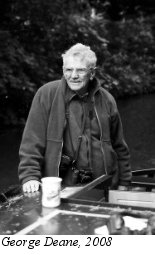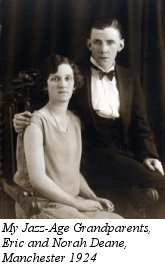But the approach was different—a leather-lunged engine pushed the passengers round and round in a corkscrew, mounting, rising; they chugged through low-level clouds and for a moment Dick lost Nicole’s face in the spray of the slanting donkey-engine
(Tender is the Night, Book II, chapter xii)
Dorothy Perkins roses dragged patiently through each compartment slowly waggling with the motion of the funicular, letting go at the last to swing back to their rosy cluster. Again and again these branches went through the car.
(Tender is the Night, Book II, chapter viii)
 After my interview with Clive James on F. Scott Fitzgerald was published, I sat down at the computer with my father George and we read through it together, until we had climbed as high as the moment where James and I discuss the ‘leather-lunged engine,’ and gloss over the phrase in puzzlement. I could tell by the expression on my father’s face that the ‘leather-lunged engine’ wasn’t something he was about to gloss over. A design engineer, not just by profession but vocation (he retired years ago but all the machines he designed still whirr and chime in his imagination) George looks at a steam engine the way I might look at a painting by Rembrandt: as a thing of beauty and a miracle of rare device, of which he always asks the question ‘How does it work?’ He told me exactly how the hydraulic engine on Fitzgerald’s mountain train would work, and I summarise his comments below.
After my interview with Clive James on F. Scott Fitzgerald was published, I sat down at the computer with my father George and we read through it together, until we had climbed as high as the moment where James and I discuss the ‘leather-lunged engine,’ and gloss over the phrase in puzzlement. I could tell by the expression on my father’s face that the ‘leather-lunged engine’ wasn’t something he was about to gloss over. A design engineer, not just by profession but vocation (he retired years ago but all the machines he designed still whirr and chime in his imagination) George looks at a steam engine the way I might look at a painting by Rembrandt: as a thing of beauty and a miracle of rare device, of which he always asks the question ‘How does it work?’ He told me exactly how the hydraulic engine on Fitzgerald’s mountain train would work, and I summarise his comments below.
He also told me another little wonder. I was delighted to discover that in the garden of the house where I write this, the house where our family has lived since 1933, is a vigorous, seemingly unkillable Dorothy Perkins rose bush. Until George told me this, I hadn’t known the name of the variety—only that the rose at the bottom of the garden, the one that guarded us from the world beyond, was an exuberant, small, pink climber with a delicate scent. My grandfather Eric planted it sometime in the mid 30s, and we have been attempting to control it ever since.
But what a recognition scene! As George recounted that story, I knew how it felt to be in the funicul ar even more clearly than I had before. Yes, the stems of the roses are long and wild, and Fitzgerald is spot on in describing the way they invade the carriage. As kids, we had to push through those long stems as we exited the garden gate and walked into the field below the house in the same way that the funicular had to push through the roses as it climbed the mountain. One summer morning years ago, I shouldered my way through those roses after rain, and then tried to write a poem about the way rain water collected on each leaf and flower and deposited icy tear-streaks down my bare back as I walked under the roses. I had forgotten that abandoned poem until this conversation. So thanks to my father, I know the engine and I know the small but tenacious Jazz-Age roses. Thanks to him, the long stretch of distance between Fitzgerald and myself evaporates and the perfumed funicular and the chugging mountain train rise up before me out of the mist.
ar even more clearly than I had before. Yes, the stems of the roses are long and wild, and Fitzgerald is spot on in describing the way they invade the carriage. As kids, we had to push through those long stems as we exited the garden gate and walked into the field below the house in the same way that the funicular had to push through the roses as it climbed the mountain. One summer morning years ago, I shouldered my way through those roses after rain, and then tried to write a poem about the way rain water collected on each leaf and flower and deposited icy tear-streaks down my bare back as I walked under the roses. I had forgotten that abandoned poem until this conversation. So thanks to my father, I know the engine and I know the small but tenacious Jazz-Age roses. Thanks to him, the long stretch of distance between Fitzgerald and myself evaporates and the perfumed funicular and the chugging mountain train rise up before me out of the mist.
F. Scott Fitzgerald is even more accurate than Clive James or I imagined in our interview. In Tender is the Night, when he talks about a ‘leather-lunged engine’ in the scene where Dick Diver sees Nicole in the train carriage, it appears that he is talking about a particular part of the mechanism. Leather was used in hydraulic and steam engines to seal cylinders and valves. Leather was the material of choice in such engines because it was tough, but also because it flexed and bridged the gap between the piston and the cylinder. Until I knew this, I had thought of the image as being purely metaphorical, a way of describing the engine’s sound. I did not realise that the metaphorical element might reside chiefly in the ‘lung’ part of the image, and this is where you get to the heart of Fitzgerald: accurate observation becoming a strange, beautiful and sonorous metaphor.
It is a metaphor that Fitzgerald does not invent but reinvents. The Merriam Webster Dictionary tells us that the phrase ‘leather-lunged’ dates back to an earlier part of the Industrial Age. The phrase ‘leather-lunged singers’ is recorded as far back as 1846, ‘leather-lunged’ suggesting the loudness of voice required by singers and other performers to project their voices in an auditorium in the days before electronic amplification. In the dictionary example, the metaphor is used to describe a human sound in terms of machinery. Fitzgerald turns the metaphor upside down and uses it to give the machine an operatic human voice.
Yet, whether we want to praise the lyricism of the image or its technical accuracy, there can be no more perfect emblem of Fitzgerald’s achievement than the ‘leather-lunged engine’— except perhaps the Dorothy Perkins roses. Either the engine or the roses could stand as ideal metaphors for Fitzgerald’s prose. The struggle of the engine and the way it arrives ‘on top of the sunshine’ puts us in mind of the way he joins beauty and energy. On the other hand, we must not forget the tough little roses pushing their way into our sensory experience, overwhelming us again and again with their delicate scent and their thorny, joyous resilience.
Nichola Deane